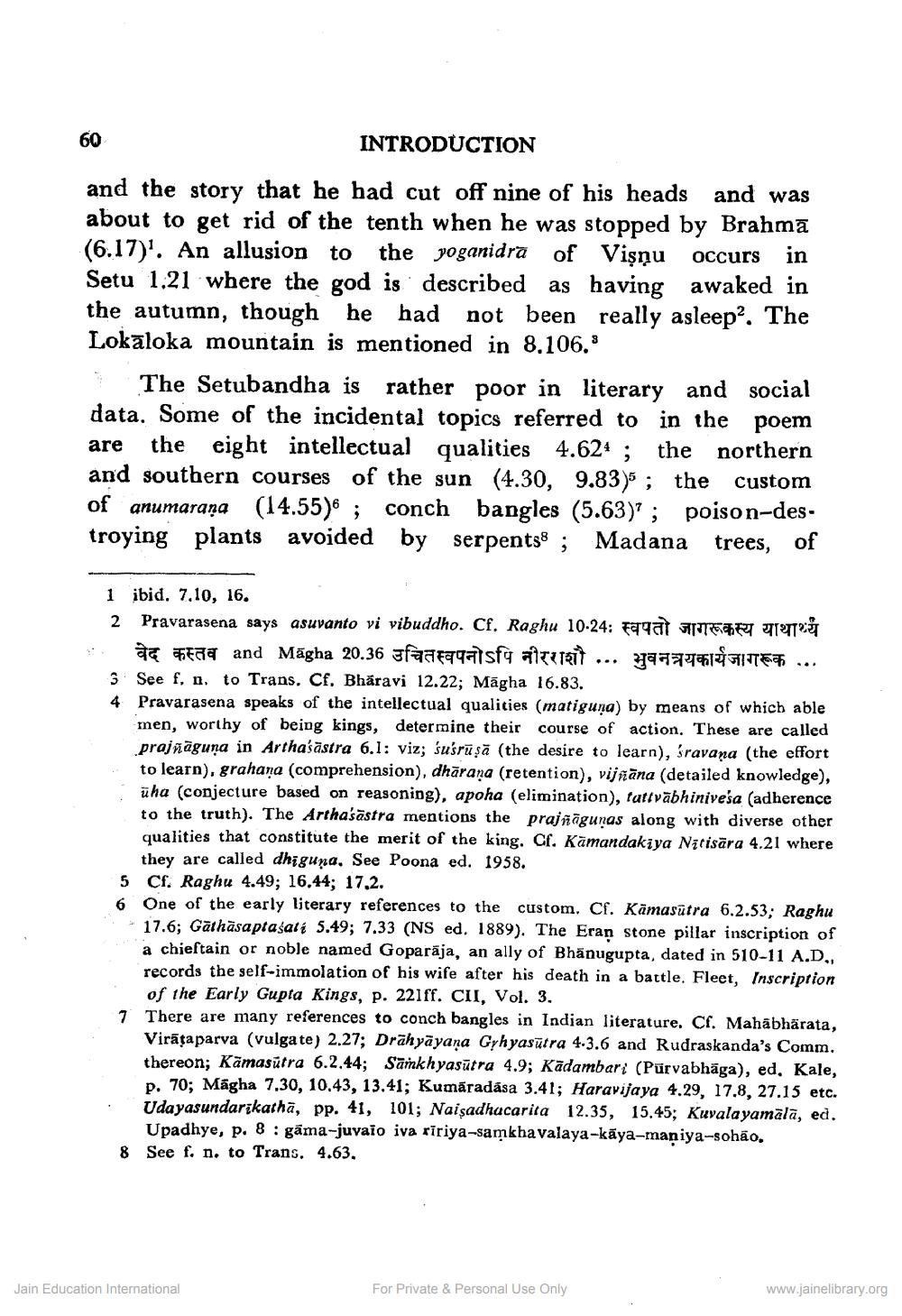________________
60
INTRODUCTION
and the story that he had cut off nine of his heads and was about to get rid of the tenth when he was stopped by Brahma (6.17)'. An allusion to the poganidra of Vişņu occurs in Setu 1.21 where the god is described as having awaked in the autumn, though he had not been really asleep?. The Lokāloka mountain is mentioned in 8.106.8
The Setubandha is rather poor in literary and social data. Some of the incidental topics referred to in the poem are the eight intellectual qualities 4.624 ; the northern and southern courses of the sun (4.30, 9.83)5 ; the custom of anumarana (14.55)6 ; conch bangles (5.63)?; poison-destroying plants avoided by serpents: ; Madana trees, of
1 ibid. 7.10, 16. 2 Pravarasena says asuvanto vi vibuddho. Cf. Raghu 10-24: Faqat ATERT OTT
9 Fra and Māgha 20.36 farqqasfa alatsit ... 4977471FTER ... 3 See f, n. to Trans. Cf. Bhāravi 12.22; Māgha 16.83. 4 Pravarasena speaks of the intellectual qualities (matigung) by means of which able
men, worthy of being kings, determine their course of action. These are called prajñāguna in Arthaśāstra 6.1: viz; susrūşā (the desire to learn), Sravana (the effort to learn), grahana (comprehension), dharana (retention), vijñāna (detailed knowledge), üha (conjecture based on reasoning), apoha (elimination), fattvābhinivesa (adherence to the truth). The Artha'sāstra mentions the prajñāgunas along with diverse other qualities that constitute the merit of the king. Cf. Kamandakiya Nīcisāra 4.21 where
they are called dhiguna. See Poona ed. 1958. 5 Cf. Raghu 4.49; 16.44; 17.2. 6 One of the early literary references to the custom. Cf. Kāmasutra 6.2.53; Raghu
17.6; Gathāsaptasalt 5.49; 7.33 (NS ed. 1889). The Eran stone pillar inscription of a chieftain or noble named Goparāja, an ally of Bhänugupta, dated in 510-11 A.D., records the self-immolation of his wife after his death in a battle. Fleet, Inscription
of the Early Gupta Kings, p. 221ff. CII, Vol. 3. 7. There are many references to conch bangles in Indian literature. Cf. Mahabhärata,
Virātaparva (vulgate) 2.27; Drähyāyana Gyhyasūtra 4.3.6 and Rudraskanda's Comm. thereon; Kamasutra 6.2.44; Sainkhyasūtra 4.9; Kādambari (Pürvabhāga), ed. Kale, p. 70; Māgha 7.30, 10.43, 13.41; Kumāradása 3.41; Haravijaya 4.29, 17.8, 27.15 etc. Udayasundarikathā, pp. 41, 101; Naişadhacarita 12.35, 15.45; Kuvalayamālā, ed.
Upadhye, p. 8 : gama-juvaio iva ririya-samkhavalaya-kāya-maniya-sohão. 8 See f. n. to Trans. 4.63.
Jain Education International
For Private & Personal Use Only
www.jainelibrary.org




